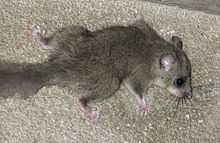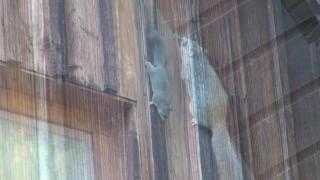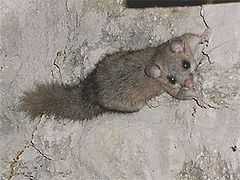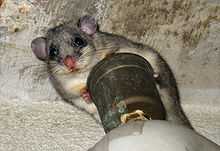Edible dormouse
| Edible dormouse Temporal range: Pleistocene–Recent | |
|---|---|
 | |
| Conservation status | |
| Scientific classification | |
| Kingdom: | Animalia |
| Phylum: | Chordata |
| Class: | Mammalia |
| Order: | Rodentia |
| Family: | Gliridae |
| Subfamily: | Glirinae |
| Genus: | Glis Brisson, 1762 |
| Species: | G. glis |
| Binomial name | |
| Glis glis (Linnaeus, 1766) | |
 | |
| Edible dormouse range | |
| Synonyms [2] | |
| |
The edible dormouse or fat dormouse (Glis glis) is a large dormouse and the only living species in the genus Glis.[3] Its name comes from the Romans, who treated it as a delicacy.
Description

The edible dormouse is the largest of all dormice, being around 14 to 19 centimetres (5.5 to 7.5 in) in head-body length, plus a 11 to 13 centimetres (4.3 to 5.1 in) long tail. It normally weighs from 120 to 150 grams (4.2 to 5.3 oz), but may almost double in weight immediately prior to hibernation. It has a generally squirrel-like body, with small ears, short legs, and large feet. Its fur is grey to greyish-brown in colour over most of the body, while the underparts and the inner surface of legs are white to pale buff; the line of demarcation is rather well defined.[4] Unlike most other dormice, there are no dark markings on the face, aside from faint rings around the eyes. The tail is long and bushy, with fur slightly darker than that on the body. Front feet have 4 digits and their hind feet have 5. The soles of their feet are naked. Females have from four to six pairs of teats.[4] .[4] The edible dormouse is capable of limited autotomy; if another animal grasps the tail, the skin breaks easily and slides off the underlying bone, allowing the dormouse to escape. The exposed vertebrae then break off and the wound heals over, forming a fresh brush of hair.[4]
Distribution
The edible dormouse is found throughout much of mainland western Europe. It is also found on a number of Mediterranean and Baltic islands, including Sardinia, Corsica, Sicily, and Crete.[5] It is rather more sparsely distributed through central Europe and the Balkans, but can be found as far north-east as the upper Volga River. Close to the Volga River, there were small groups of the species found at the Zhiguli Mountains, in Russia.[6] They are also found in the Caucasus region, and along the southern coast of the Caspian Sea.[4] Germany has a small population of edible dormice within its borders, ranging from two to six individuals per hectare.[7]
Beyond Europe, it is found in scattered populations throughout Thrace, located on the southeastern tip of the Balkan peninsula. In this region, two subspecies of the edible dormouse are found, G. g. glis and G. g. orientalis. In northern Anatolia, there is a different subspecies, G. g pindicus[8]
It was accidentally introduced to the town of Tring in England through an escape from Lionel Walter Rothschild's private collection in 1902.[9] As a result, the British edible dormouse population, now 30,000 strong,[10][11] is concentrated in a 200-square-mile (520 km2) triangle between Beaconsfield, Aylesbury and Luton, around the south east side of the Chiltern Hills.[12]
Though this animal is regarded as a pest by some,[9] in the United Kingdom the Wildlife and Countryside Act 1981 prohibits certain methods of killing and taking it, and removing them may require a licence.[11]
Ecology and habitat
Edible dormice inhabit deciduous forests dominated by oak and beech, from sea level to the upper limits of such forests at 1,500 to 2,000 metres (4,900 to 6,600 ft). They prefer dense forests with rocky cliffs and caves, but may be found in maquis vegetation, orchards, and urban margins. They have frequently been reported from caves as deep as 400 metres (1,300 ft), where they can shelter from predators.[4]
Population densities range from 2 to 22 individuals per hectare.[13] Females inhabit only very small home ranges, of 0.15 to 0.76 hectares (0.37 to 1.88 acres), but males occupy much larger ranges of 0.8 to 7 hectares (2.0 to 17.3 acres), with several burrows.[14]
Edible dormice are primarily herbivorous, feeding mainly on berries, apples, and nuts. However, they are adaptable, and have also been reported to eat bark, leaves, flowers, invertebrates, and even eggs. Beech mast, which is rich in energy in protein, is an excellent source of food for young and lactating females.[4] Studies show that some dormice are found to have hair and ectoparasite remains in their stomachs, but this is mainly due to accidental ingestion during grooming.[15]
Edible dormice also consume large numbers of beech tree seeds. A single, large, seeding tree within the home range of a dormouse will produce enough resources to support the energy requirements of reproduction. The location and age of a beech tree will help dictate where a population of dormice will live, since older trees produce more seeds.[16]
When present in large numbers, they may cause damage to orchards and be considered a pest. Their primary predators include owls, foxes, pine martens, and wildcats.[4]
Behaviour

Edible dormice are nocturnal, spending the day in nests taken from birds, or located in hollow trees or similar shelter. They are good climbers, and spend most of their time in the trees, although they are relatively poor jumpers. The dormouse uses sticky secretions of plantar glands when they are climbing on smooth surfaces to prevent them from falling.[4] They generally like to stay in the forest and avoid open areas to any extent.[13] They are not generally social animals, although small groups of closely related adults have occasionally been reported.[17] Many edible dormice mothers form communal nesting areas where they care for their young together.[4]
Communication is partly by sound, with the animals making various squeaks or snuffling sounds, and partly by scent. They leave scent trails from scent glands on feet as well as glands at the top of their tail by its anus. They rub their anal region on the ground and places they walk, so that traces of the secretion will be left for other dormice,[4] especially during periods of sexual activity. Edible dormice are active during a 6-month period and go into hibernation[13] from roughly October to May, depending on local climatic conditions. They are mostly active in the summer time and research has shown they are active on average 202 minute in a 24-hour day, mostly at night.[6] They prepare a den in soft soil or hidden in a cave, and rely on fat reserves to survive through the winter. During hibernation, metabolic rate and body temperature fall dramatically, and the animal may cease breathing altogether for periods of up to an hour.[18]
They have adapted well to the presence of man and will now frequently hibernate in insulated attics and even dark shelves in cupboards, particularly if there are soft materials on the shelf to make a nest. They can be regarded as a pest in this situation due to the fire risk from gnawed electrical cables and fouling from their faeces. In recent years they have become resistant to many rodicides. In the wild most edible dormice hibernate for three winters, and then die in the fourth while hibernating, when their cheek teeth are worn out to a degree that prevents normal mastication of food.[19]
Reproduction
The breeding season is from late June to mid August, however, both male and female dormice do not produce every year.[20] Variation in food resources strongly influences reproduction because reproduction is tightly linked to the availability of energy-rich seeds.[21] Therefore, edible dormice breed during the phase of high food availability. Females are able to produce additional young if amino acid rich foods like inflorescences, unripe seeds and (or) larval insects, which also increase their numbers by eating the same enriched plant food, are available.[22] An abundance of energy-rich seeds allows newborn dormice to increase their body fat to prepare for their first hibernation.[21] Females will reach sexual maturity at 351–380 days old and males will significantly lower their body mass during mating season.[23]
Males are non-territorial, and may visit the territories of several nearby females to mate, becoming aggressive to any other males they encounter. The male attracts a female by squeaking, then conducts a circular courtship dance before mounting her. During mating season, males lower their body mass and use their body fat reserves to help fuel the energetic costs of reproduction.[23]
Gestation lasts from 20–31 days, and results in the birth of anything up to eleven young, although four or five is more typical.[4] They develop their fur by 16 days, and open their eyes after around 3 weeks. They begin to leave the nest after around 30 days, and are sexually mature by the time they complete their second hibernation.[4] Compared with similarly sized mammals, they have an unusually long lifespan, and have been reported to live up to twelve years in the wild.[24]
Evolution
Although the edible dormouse is the only living member of its genus, a number of fossil species are also known. The genus Glis first originated in the middle Oligocene, although it did not become common until the Pliocene. By the Pleistocene, only one species, Glis sackdillingensis, is known to have survived, and this is likely the ancestor of the modern species, which first appeared in the early to mid-Pleistocene.[4]
Edible dormice that have been isolated on oceanic islands are a prime example of insular gigantism, in which small animals in isolated locations become larger over the course of many generations.[19] Although it is not known why, the number of teats on a female edible dormouse across regions of Europe varies. For example, those in Italy have two to seven, while those in Lithuania have three to six.[25]
Cuisine

The edible dormouse was farmed and eaten by the ancient Romans and the Etruscans (usually as a snack), hence the word edible in its name. The Romans would catch the dormice from the wild in autumn when it was fattest.[26] The dormice were kept and raised either in large pits or (in less spacious urban surroundings) in terra cotta containers, the gliraria,[27] something like contemporary hamster cages. They fed these captive dormice walnuts, chestnuts, and acorns for fattening. The dormice were served by either roasting them and dipping them in honey or stuffing them with a mixture of pork, pine nuts, and other flavorings.[26] It was however very important to upper-class Romans that the dormice be separated from other products of the hunt, like the large game, for presentation purposes.[28]
To this day, wild edible dormice are consumed in Slovenia, where they are considered a rare delicacy and dormouse trapping an ethnic tradition. They use several methods of trapping. The first used were the hollow tree trapping method and the flat stone trapping method. By the 17th century the peasant trappers had invented the first self-triggering traps, usually made out of different kinds of wood. In the 19th century traps made from iron and steel were introduced. The trappers used many different types of bait to entice the dormice. These different types of bait ranged from pieces of fruit to bacon soaked in brandy. During the prime season a trapper could catch between 200 and 400 dormice depending largely on what kind of trap they were using. The people of Slovenia did not just catch the dormice for their meat.[29] Use of dormice for food and fur and of dormouse fat as a medicament is documented there since the 13th century. Seasonal dormice feasts were welcome protein supplements for the impoverished peasantry.[30]
References
- ↑ Amori, G. et al. (2010). Glis glis. In: IUCN 2008. IUCN Red List of Threatened Species. Retrieved 9 October 2010.
- ↑ Carlo Violani & Bruno Zava (1995). "Carolus Linnaeus and the edible dormouse" (PDF). Hystrix 6 (1–2): 109–115. doi:10.4404/hystrix-6.1-2-4020.
- ↑ Holden, M. E. (2005). "Family Gliridae". In Wilson, D. E.; Reeder, D. M. Mammal Species of the World (3rd ed.). Johns Hopkins University Press. p. 841. ISBN 978-0-8018-8221-0. OCLC 62265494.
- ↑ 4.0 4.1 4.2 4.3 4.4 4.5 4.6 4.7 4.8 4.9 4.10 4.11 4.12 4.13 Kryštufek, B. (2010). "Glis glis (Rodentia: Gliridae)". Mammalian Species 42 (1): 195–206. doi:10.1644/865.1.
- ↑ Milazzo, A.; Faletta, W.; Sarà, M. (2003). "Habitat Selection of Fat Dormouse (Glis glis italicus) in Deciduous Woodlands of Sicily". Acta Zoologica Academiae Scientiarum Hungaricae. Suppl. I: 117–124.
- ↑ 6.0 6.1 Ivashkina, Victoria (2006). "Abundance and Activity of the Edible Dormouse Glis glis L. in the Zhiguli Mountains, Russia, Middle Volga Region" (PDF). Polish journal of ecology 54 (3): 337–344.
- ↑ Burgess, M., Morris, P. and Bright, P. (2003). "Population Dynamics of the Edible Dormouse (Glis glis) in England" (PDF). Acta Zoologica Academiae Scientiarum Hungaricae 49. Suppl. I: 27–31.
- ↑ Selçuk, Senem Esin; Reyhan Çolak; Gül Olgun Karacan; Ercüment Çolak (2011). "Population Structure of Edible Dormouse, Glis glis (Linnaeus, 1766) in Turkey, Inferred from RaPD-PcR" (PDF). Acta Zoologica Bulgarica: 77–83.
- ↑ 9.0 9.1 Richard Creasey (2006-10-23). "Invasion of the Glis glis". Daily Mail. Retrieved 2008-03-29.
- ↑ Dormouse in Britain http://www.telegraph.co.uk/news/earth/wildlife/7549315/Edible-dormouse-listed-among-Britains-great-wildlife-threats.html
- ↑ 11.0 11.1 "Edible Dormice (Glis glis)". Natural England. 2008-11-11. Retrieved 2009-05-02.
- ↑ "The Glis glis Around Amersham." Amersham - News, Views and Information. 3 October 2007
- ↑ 13.0 13.1 13.2 Bieber, C. (1995). "Dispersal behaviour of the edible dormouse (Myoxus glis L.) in a fragmented landscape in central Germany". Hystrix 6 (1): 257–263.
- ↑ Ściński, M. & Borowski, Z. (2008). "Spatial organization of the fat dormouse (Glis glis) in an oak-hornbeam forest during the mating and post-mating season". Mammalian Biology 73 (2): 119–127. doi:10.1016/j.mambio.2007.01.002.
- ↑ Gigirey, Antonio; Jose M. Rey (June 1998). "Autumn diet of the edible dormouse in Galicia, northwest Spain" (PDF). Acta Theriologica 43 (3): 325–328. Retrieved October 24, 2013.
- ↑ Lebl, Karin; Birgit Rotter; Klaus Kurbisch; Claudia Bieber; Thomas Ruf (October 2011). "Local environmental factors affect reproductive investment in female edible dormice". Journal of Mammalogy 92 (5): 926–933. doi:10.1644/10-MAMM-A-225.1.
- ↑ Marin, G. & Pilastro, A. (1994). "Communally breeding dormice, Glis glis, are close kin". Animal Behaviour 47: 1485–1487. doi:10.1006/anbe.1994.1201.
- ↑ Wilz, M. et al. (2000). "Intermittent ventilation in hibernating dormice—is ventilation always necessary to meet metabolic demands?". Life in the cold. Eleventh International Hibernation Symposium: 169–178.
- ↑ 19.0 19.1 Kryštufek, Boris; Medeja Pistonik; Ksenija Sedmak Časar (2005). "Age determination and age structure in the edible dormouse Glis glis based on incremental bone lines". Mammal Review 35 (2): 210–214. doi:10.1111/j.1365-2907.2005.00056.x.
- ↑ Lebl, Karin; Claudia Bieber; Peter Adamik; Joanna Fietz; Pat Morris; Andrea Pilastro; Thomas Ruf (October 2010). "Survival rates in a small hibernator, the edible dormouse: a comparison across Europe" (PDF). Ecography 34: 683–692. doi:10.1111/j.1600-0587.2010.06691.x. Retrieved October 24, 2013.
- ↑ 21.0 21.1 Lebl, Karin; Birgit Rotter; Klaus Kurbisch; Claudia Bieber; Thomas Ruf (2011). "Local environmental factors affect reproductive investment in female edible dormice". Journal of Mammalogy 92 (5): 926–933. doi:10.1644/10-MAMM-A-225.1. Retrieved October 24, 2013.
- ↑ Kager, T.; J. Fietz (2009). "Food availability in spring influences reproductive output in the seed-preying edible dormouse (Glis glis)". Can. J. Zool 87: 555–565. doi:10.1139/z09-040. Retrieved October 24, 2013.
- ↑ 23.0 23.1 Sailer, Michaela; Joanna Fietz (2008). "Seasonal differences in the feeding ecology and behavior of male edible dormice (Glis glis)" (PDF). Mammalian Biology 74: 114–124. doi:10.1016/j.mambio.2008.05.005. Retrieved October 24, 2013.
- ↑ Pilastro, A. et al. (2003). "Long living and reproduction skipping in the fat dormouse" (PDF). Ecology 84 (7): 1784–1792. doi:10.1890/0012-9658(2003)084[1784:llarsi]2.0.co;2.
- ↑ Krytufek, Boris (2004). "Nipples in the edible dormouse Glis glis" (PDF). Folia Zoologica 53 (1): 107–111.
- ↑ 26.0 26.1 Fiedler, Lynwood A., "Rodents as a Food Source" (1990). Proceedings of the Fourteenth Vertebrate Pest Conference 1990. Paper 30. http://digitalcommons.unl.edu/vpc14/30
- ↑ E. Saglio, "Glirarium". In Daremberg and Saglio, Dictionnaire des Antiquités Grecques et Romaines, Tome II (Volume 2), page 1613, Librairie Hachette et Cie., Paris, 1877–1919.
- ↑ D'Arms, John H. (2004). "The Culinary Reality of Roman Upper-Class Convivia: Integrating Texts and Images". Society for Comparative Study of Society and History: 428–450.
- ↑ Magda Peršič (1998). "Dormouse hunting as part of Slovene national identity" 7 (3). Croatian Natural History Museum. pp. 199−211. ISSN 1330-0520.
- ↑ Haberl, Werner. "Dormouse Hunting in Slovenian Tradition." Dormouse Culture, Tradition & Myths. 2007. 3 October 2007
External links
| Wikimedia Commons has media related to: |
- The Dormouse Hollow
 Data related to Glis glis at Wikispecies
Data related to Glis glis at Wikispecies
| ||||||||||||||||||||||||||||||||||||||||||||||||||||
